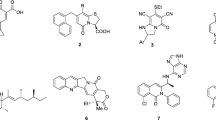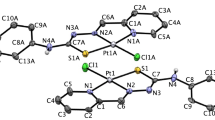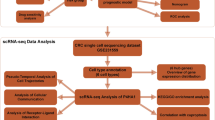Abstract
Aim:
Platinum-(IV)-derivative satraplatin represents a new generation of orally available anti-cancer drugs that are under development for the treatment of several cancers. Understanding the mechanisms of cell cycle modulation and apoptosis is necessary to define the mode of action of satraplatin. In this study, we investigate the ability of satraplatin to induce cell cycle perturbation, clonogenicity loss and apoptosis in colorectal cancer (CRC) cells.
Methods:
CRC cells were treated with satraplatin, and the effects of satraplatin on apoptosis and the cell cycle were evaluated by flow cytometry. Western blot analysis was used to investigate the effects of satraplatin on cell cycle and apoptosis-related proteins. RT-qPCR was used to evaluate p53-related mRNA modulation.
Results:
Satraplatin induced an accumulation of CRC cells predominantly in the G2/M phase. Increased p53 protein expression was observed in the p53 wild-type HCT116 and LoVo cells together with p21waf1/cip1 protein up-regulation. However, p21waf1/cip1 protein accumulation was not observed in the p53 mutant HCT15, HT29, and WiDr cells, even when p53 protein expression was compromised, suggesting that the cell cycle perturbation is p53-p21waf1/cip1 independent. Following a candidate approach, we found an elevated expression of 14-3-3σ protein levels in CRC cells, which was independent of the status of p53, further supporting the role of satraplatin in the perturbation of the G2/M cell cycle phase. Moreover, satraplatin treatment induced apoptosis along with Bcl-2 protein down-regulation and abrogated the clonogenic formation of CRC cells in vitro.
Conclusion:
Collectively, our data suggest that satraplatin induces apoptosis in CRC cells, which is preceded by cell cycle arrest at G2/M due to the effect of 14-3-3σ and in a p53-p21waf1/cip1–independent manner. Taken together, these findings highlight the potential use of satraplatin for CRC treatment.
Similar content being viewed by others
Log in or create a free account to read this content
Gain free access to this article, as well as selected content from this journal and more on nature.com
or
References
Johnson NP, Butour JL, Villani G, Wimmer FL, Defais M, Pierson V . Metal antitumor compounds: the mechanism of action of platinum complexes. Prog Clin Biochem Med 1989; 10: 1–24.
Johnson SW, Ferry KV, Hamilton TC . Recent insights into platinum drug resistance in cancer. Drug Resist Update 1998; 1: 243–54.
Fuertes MA, Castilla J, Alonso C, Perez JM . Cisplatin biochemical mechanism of action: From cytotoxicity to induction of cell death through interconnections between apoptotic and necrotic pathways. Curr Med Chem 2003; 10: 257–66.
Boulikas T, Pantos A, Bellis E, Christofis P . Designing platinum compounds in cancer: structures and mechanisms. Cancer Therapy 2007; 5: 537–83.
Kelland LR, Abel G, McKeage MJ, Jones M, Goddard PM, Valenti M, et al. Preclinical antitumor evaluation of bis-acetato-ammine-dichloro-cyclohexylamine platinum (IV): an orally active platinum drug. Cancer Res 1993; 53: 2581–6.
Sharp SY, Rogers PM, Kelland LR . Transport of cisplatin and bis-acetato-ammine-dichlorocyclohexylamine platinum (IV) (JM-216) in human ovarian carcinoma cell lines: identification of a plasma membrane protein associated with cisplatin resistance. Clin Cancer Res 1995; 1: 981–9.
Choy H, Park C, Yao M . Current status and future prospects for satraplatin, an oral platinum analogue. Clin Cancer Res 2008; 14: 1633–8.
Elledge SJ . Cell cycle checkpoints: preventing an identity crisis. Science 1996; 274: 1664–72.
Bartek J, Lukas J . Pathways governing G1/S transition and their response to DNA damage. FEBS Lett 2001; 490: 117–22.
Taylor WR, Stark GR . Regulation of the G2/M transition by p53. Oncogene 2001; 20: 1803–15.
Levine AJ . p53, the cellular gatekeeper for growth and division. Cell 1997; 88: 323–31.
Bunz F, Dutriaux, Lengauer C, Waldman T, Zhou S, Brown JP, et al. Requirement for p53 and p21 to sustain G2 arrest after DNA damage. Science 1998; 282: 1497–501.
Waldman T, Kinzler KW, Vogelstein B . p21 is necessary for the p53-mediated G1 arrest in human cancer cells. Cancer Res 1995; 55: 5187–90.
Kalimutho M, Minutolo A, Grelli S, Formosa A, Sancesario G, Valentini A, et al. Satraplatin (JM-216) mediates G2/M cell cycle arrest and potentiates apoptosis via multiple death pathways in colorectal cancer cells thus overcoming platinum chemo-resistance. Cancer Chemother Pharmacol 2010; 67: 1299–312.
UKCCR. UKCCCR guidelines for the use of cell lines in cancer research. British J Cancer 2000; 82: 1495–509.
Han Z, Wei W, Dunaway S, Darnowski JW, Calabresi P, Sedivy J, et al. Role of p21 in apoptosis and senescence of human colon cancer cells treated with camptothecin. J Biol Chem 2002; 277: 17154–60.
Fokkema E, Groen HJM, Bauer J, Uges DRA, Weil C, Smith IE . Phase II study of oral platinum drug JM216 as first line treatment in patients with small-cell lung cancer. J Clin Oncol 1997; 17: 3822–7.
McKeage MJ, Mistry P, Ward J, Boxall FE, Loh S, O'Neill C, et al. A phase I and pharmacology study of an oral platinum complex, JM216: dose-dependent pharmacokinetics with single-dose administration. Cancer Chemother Pharmacol 1995; 36: 451–8.
Latif T, Wood L, Connell C, Smith DC, Vaughn D, Lebwohl D, et al. Phase II study of oral bis(acetate) ammine dichloro (cyclohexylamine) platinum (IV) (JM216, BMS-182751) given daily x 5 in hormone refractory prostate cancer (HRPC). Invest New Drug 2005; 23: 79–84.
Sternberg CN, Whelan P, Hetherington J, Paluchowska B, Slee PH, Vekemans K, et al. Phase III trial of satraplatin, an oral platinum plus prednisone vs prednisone alone in patients with hormone-refractory prostate cancer. Oncology 2005; 68: 2–9.
Ormerod MG, Orr RM, Peacock JH . The role of apoptosis in cell killing by ciplatin: a flow cytometric study. Br J Cancer 1994; 69: 93–100.
Hermeking H, Lengauer C, Polyak K, He TC, Zhang L, Thiagalingam S, et al. 14-3-3 sigma is a p53-regulated inhibitor of G2/M progression. Mol Cell 1997; 1: 3–11.
Yadav SS, Sindram D, Perry DK, Clavien PA . Ischemic preconditioning protects the mouse liver by inhibition of apoptosis through a caspase-dependent pathway. Hepatology 1999; 30: 1223–31.
Rao L, White E . Bcl-2 and the ICE family of apoptotic regulators: making a connection. Curr Opin Genet 1997; 7: 52–8.
Reardon JT, Vaisman A, Chaney SG, Sancar A . Efficient nucleotide excision repair of cisplatin, oxaliplatin, and bis-aceto-ammine-dichloro-cyclohexylamineplatinum (IV) (JM216) platinum intrastrand DNA diadducts. Cancer Res 1999; 59: 3968–71.
Fink D, Nebel S, Aebi S, Zheng H, Cenni B, Nehmé A, et al. The role of DNA mismatch repair in platinum drug resistance. Cancer Res 1996; 56: 4881–6.
Vaisman A, Lim SE, Patrick SM, Copeland WC, Hinkle DC, Turchi JJ, et al. Effect of DNA polymerases and high mobility group protein 1 on the carrier ligand specificity for translesion synthesis past platinum-DNA adducts. Biochemistry 1999; 38: 11026–39.
Fokkema E, Groen HJ, Helder MN, de Vries EG, Meijer C . JM216-, JM118-, and cisplatin-induced cytotoxicity in relation to platinum-DNA adduct formation, glutathione levels and p53 status in human tumour cell lines with different sensitivities to cisplatin. Biochem Pharmacol 2002; 63: 1989–96.
Acknowledgements
This work was supported by grants from the University Hospital Tor Vergata and the Department of Internal Medicine, University of Rome, “Tor Vergata”. Murugan KALIMUTHO was supported by the Pre-doctoral Scholarship for foreign students under the International Italian Government University scholarship. We thank to Dr Isabella FARAONI, University of Rome Tor Vergata, Dr Soddu and Dr Maurizio FRANCULLI from the Regina Elena Cancer Institute, Rome, Italy, Dr Rossana SUPINO from the Instituto Nazionale Tumori, Milan, Italy and Prof Bert VOGELSTEIN from the Ludwig Center at John Hopkins, USA for providing us with the cell lines used in analysis. We also thank Agennix for providing us with satraplatin.
Author information
Authors and Affiliations
Corresponding author
Additional information
Supplementary tables are available at Acta Pharmacologica Sinica website of NPG.
Supplementary information
Supplementary Table 1
Cell cycle perturbation folowing different concentrations of satraplatin (XLS 22 kb)
Supplementary Table 2
qRT-PCR relative fold changed expression data for p53 signaling pathway related genes following satraplatin treatment at 48 hours (5 μM) (XLS 36 kb)
Rights and permissions
About this article
Cite this article
Kalimutho, M., Minutolo, A., Grelli, S. et al. Platinum-(IV)-derivative satraplatin induced G2/M cell cycle perturbation via p53-p21waf1/cip1-independent pathway in human colorectal cancer cells. Acta Pharmacol Sin 32, 1387–1396 (2011). https://doi.org/10.1038/aps.2011.107
Received:
Accepted:
Published:
Issue date:
DOI: https://doi.org/10.1038/aps.2011.107
Keywords
This article is cited by
-
Effect of microvesicles from Moringa oleifera containing miRNA on proliferation and apoptosis in tumor cell lines
Cell Death Discovery (2020)
-
Blockade of PDGFRβ circumvents resistance to MEK-JAK inhibition via intratumoral CD8+ T-cells infiltration in triple-negative breast cancer
Journal of Experimental & Clinical Cancer Research (2019)
-
Olea europaea small RNA with functional homology to human miR34a in cross-kingdom interaction of anti-tumoral response
Scientific Reports (2018)



